Preparation H is an American brand of medications that is made by Pfizer, used in the treatment of hemorrhoids. Hemorrhoids are caused at least in part by inflamed blood vessels, and most versions of Preparation H work by reducing inflammation in blood vessels.

Andrew Newell Wyeth was an American visual artist, primarily a realist painter, working predominantly in a regionalist style. He believed he was also an abstractionist, portraying subjects in a new, meaningful way. The son of N. C. Wyeth and father of Jamie Wyeth, he was one of the best-known U.S. artists of the middle 20th century. James H. Duff explores the art and lives of the three men in An American Vision: Three Generations of Wyeth Art. Raised with an appreciation of nature, Wyeth took walks that fired his imagination. Henry David Thoreau, Robert Frost, and King Vidor's The Big Parade (1925) inspired him intellectually and artistically. Wyeth featured in a documentary The Metaphor in which he discussed Vidor's influence on the creation of his works of art, like Winter 1946 and Portrait of Ralph Kline. Wyeth was also inspired by Winslow Homer and Renaissance artists.
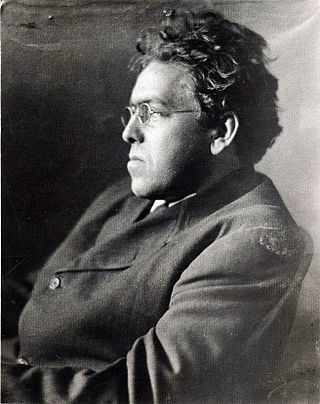
Newell Convers Wyeth, known as N. C. Wyeth, was an American painter and illustrator. He was a student of Howard Pyle and became one of America's most well-known illustrators. Wyeth created more than 3,000 paintings and illustrated 112 books — 25 of them for Scribner's, the Scribner Classics, which is the body of work for which he is best known. The first of these, Treasure Island, was one of his masterpieces and the proceeds paid for his studio. Wyeth was a realist painter at a time when the camera and photography began to compete with his craft. Sometimes seen as melodramatic, his illustrations were designed to be understood quickly. Wyeth, who was both a painter and an illustrator, understood the difference, and said in 1908, "Painting and illustration cannot be mixed—one cannot merge from one into the other."
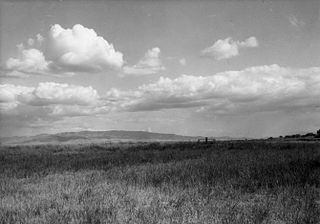
Fort Hall was a fort in the Western United States that was built in 1834 as a fur trading post by Nathaniel Jarvis Wyeth. It was located on the Snake River in the eastern Oregon Country, now part of present-day Bannock County in southeastern Idaho. Wyeth was an inventor and businessman from Boston, Massachusetts, who also founded a post at Fort William, in present-day Portland, Oregon, as part of a plan for a new trading and fisheries company. In 1837, unable to compete with the powerful British Hudson's Bay Company, based at Fort Vancouver, Wyeth sold both posts to it. Great Britain and the United States both operated in the Oregon Country in these years.

Echothiophate (Phospholine) is an irreversible acetylcholinesterase inhibitor.
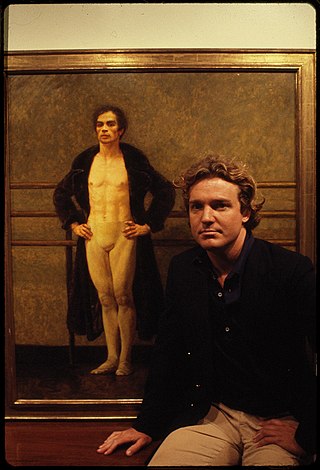
James Browning Wyeth is an American realist painter, son of Andrew Wyeth, and grandson of N.C. Wyeth. He was raised in Chadds Ford Township, Pennsylvania, and is artistic heir to the Brandywine School tradition — painters who worked in the rural Brandywine River area of Delaware and Pennsylvania, portraying its people, animals, and landscape.
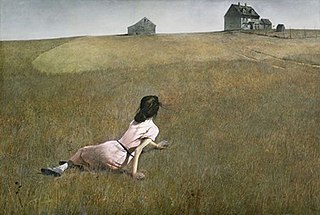
Christina's World is a 1948 painting by American painter Andrew Wyeth and one of the best-known American paintings of the mid-20th century. It is a tempera work done in a realist style, depicting a woman semi-reclining on the ground in a treeless, mostly tawny field, looking up at a gray house on the horizon; a barn and various other small outbuildings are adjacent to the house. It is held by the Museum of Modern Art, in New York.

Desvenlafaxine, sold under the brand name Pristiq among others, is a medication used to treat depression. It is an antidepressant of the serotonin-norepinephrine reuptake inhibitor (SNRI) class and is taken by mouth. It is recommended that the need for further treatment be occasionally reassessed. It may be less effective than its parent compound venlafaxine, although some studies have found comparable efficacy.

Nathaniel C. Wyeth was an American mechanical engineer and inventor. He is best known for creating a variant of polyethylene terephthalate that could withstand the pressure of carbonated liquids. Made of recyclable PET plastic, lighter than glass and virtually unbreakable, Wyeth's invention is used widely today for both carbonated and non-carbonated drinks.
Fort William was a fur trading outpost built in 1834 by the American Nathaniel Jarvis Wyeth, a Boston merchant, backed by American investors. It was located on the Columbia River on Wappatoo Island near the future Portland, Oregon. After a few years, in 1837 Wyeth sold the post to the British Hudson's Bay Company, which had much more power in the region from its base at Fort Vancouver on the north side of the Columbia River near Fort William.
Stamulumab (MYO-029) is an experimental myostatin inhibiting drug developed by Wyeth Pharmaceuticals for the treatment of muscular dystrophy (MD). Stamulumab was formulated and tested by Wyeth in Collegeville, Pennsylvania. Myostatin is a protein that inhibits the growth of muscle tissue, stamulumab is a recombinant human antibody designed to bind to and inhibit the activity of myostatin.

Methylnaltrexone, used in form of methylnaltrexone bromide, is a medication that acts as a peripherally acting μ-opioid receptor antagonist that acts to reverse some of the side effects of opioid drugs such as constipation without significantly affecting pain relief or precipitating withdrawals. Because MNTX is a quaternary ammonium cation, it cannot cross the blood–brain barrier, and so has antagonist effects throughout the body, counteracting effects such as itching and constipation, but without affecting opioid effects in the brain such as pain relief. However, since a significant fraction of opioid analgesia can be mediated by opioid receptors on peripheral sensory neurons, particularly in inflammatory conditions such as arthritis, traumatic or surgical pain, MNTX may increase pain under such circumstances.

Bifeprunox (INN) (code name DU-127,090) is an atypical antipsychotic which, similarly to aripiprazole, combines minimal D2 receptor agonism with serotonin receptor agonism. It was under development for the treatment of schizophrenia, psychosis and Parkinson's disease.

The N. C. Wyeth House and Studio is a historic house museum and artist's studio on Murphy Road in Chadds Ford Township, Pennsylvania, United States. Beginning with its construction in 1911, it served as the principal home and studio of artist N.C. Wyeth (1882-1945). It was restored to its original appearance around the time of his death. The property is managed by the Brandywine River Museum, which offers tours. It was designated a National Historic Landmark District in 1997.
Wyeth is an unincorporated locale in Hood River County, Oregon, United States. It is the site of a campground area in the Columbia River Gorge National Scenic Area off Interstate 84 (I-84).

Wyeth was a pharmaceutical company until it was purchased by Pfizer in 2009. The company was founded in Philadelphia, Pennsylvania, in 1860 as John Wyeth and Brother. Its headquarters moved to Collegeville, Pennsylvania, and Madison, New Jersey, before its headquarters were consolidated with Pfizer's in New York City after the 2009 merger.

John Allan Wyeth served as a lieutenant in the American Expeditionary Forces during World War I and subsequently became a war poet, composer, and painter. After the Armistice, Wyeth lived in Europe and became both a Post-Impressionist painter and a war poet.

Pipendoxifene (INN) is a nonsteroidal selective estrogen receptor modulator (SERM) that was under development by Ligand Pharmaceuticals and Wyeth-Ayerst Laboratories for the treatment of breast cancer but was not marketed. It is a member of the 2-phenylindole group of SERMs and is structurally related to zindoxifene and the marketed bazedoxifene. The drug reached phase II clinical trials before its development was discontinued. It was synthesized at the same time as bazedoxifene and was intended as a backup drug for bazedoxifene, only to be developed further if bazedoxifene had failed in clinical trials. No further development was reported after 2002 and it was formally announced that development had been terminated in November 2005.
Nestlé-Wyeth Nutrition provides food products to meet the needs of infants, young children and adults. Through scientific research, they claim to help nourish children when breastfeeding is not an option. Wyeth Nutrition started in 1915 when Henry Grestberger manufactured the first formula patterned after breast milk called SMA. Wyeth Pharmaceuticals, formerly Wyeth-Ayerst Laboratories, is the original company founded by the Wyeth brothers, originally known as John Wyeth and Brother. They focused on the research, development, and marketing of prescription drugs. The pharmaceuticals division was further subdivided into five subdivisions: Wyeth Research, Prescription Products, Biotech, Vaccines, and Nutritionals. Wyeth's research and development director Robert Ruffolo was quoted in The New York Times about the firm's efforts to develop new drugs.
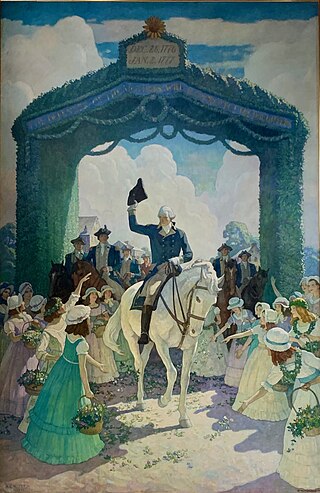
Reception to Washington on April 21, 1789, at Trenton on his way to New York to Assume the Duties of the Presidency of the United States is a large-scale oil painting completed in 1930 by American artist N. C. Wyeth of president-elect George Washington at his reception in Trenton, New Jersey during his journey to the 1789 inauguration in New York City. The mural was commissioned by the First Mechanics National Bank of Trenton, now part of Wells Fargo. It has been on display in the lobby of Thomas Edison State University since 2013. Wells Fargo donated the painting to the university in 2019, the most expensive gift ever given to the university.














